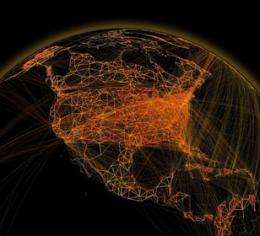IU informaticists show new levels of refinement in predicting human mobility, epidemic spread

(PhysOrg.com) -- The interplay of human mobility patterns like those between local metropolitan commuters and long-range airline travelers during a global epidemic can be modeled in such detail so as to offer refined views of epidemics that could aid in public health emergency decision making, according to new research published by a team led by informaticists at Indiana University.
The findings, published this week in the Proceedings of the National Academy of Sciences' Online Early Edition, also note that with these refined computational strategies, new levels of accuracy about the behavior of targeted mobility networks and epidemic progression can be imagined.
The research team, led by IU informaticist and physicist Alessandro Vespignani, also found that with these strategies a better balance could be struck during a real-time public health emergency between needed computational time and refining the flexibility of human mobility and infectious disease models.
"The present analysis opens the path to quantitative approximation schemes that calibrate the level of data resolution and the needed computational resources with respect to the accuracy in the description of the epidemics," said Vespignani, Rudy Professor in the School of Informatics and Computing. "These results already have contributed to the improvement of the computational models we use to provide estimates and projections of the H1N1 pandemic."
Using population data centered around the locations of 220 International Air Transport Association-indexed airports, the group identified a data set of 3,363 subpopulations that was put into a model along with commuting data from 29 countries in five continents. Once the two data sets were mapped into the model, commuting networks were constructed at the subpopulation level, and a third data layer for a hypothetical pandemic influenza was included.
Simulations were then conducted that allowed the researchers to discriminate between the main contributions of both the long- (air traffic) and short-range (commuter) mobility flows to the pandemic spread.
"The global epidemic behavior is governed by the long-range airline traffic that determines the arrival of infectious individuals on a worldwide scale," Vespignani said. "At the local level, however, the short-range epidemic coupling induced by commuting flows creates a synchrony between neighboring regions and a local diffusive pattern with the epidemic flowing from subpopulations with major hubs into the neighboring subpopulations."
From a computational modeling perspective, Vespignani said the research is important in that it helps determine two things -- whether or not there may be one mobility scale most relevant toward defining a global epidemic pattern, and at which level of resolution of the epidemic's behavior does any given mobility scale become relevant.
When the researchers removed commuting flows from the worldwide air traffic model, the large scale pattern of the epidemic showed only small variations. On the other hand, the team found short-range mobility in the model increases the synchronization of subpopulations in close proximity and affects the epidemic behavior at the periphery of major transportation hubs.
"This approach outlines the possibility for the definition of layered computational approaches where different modeling assumptions and granularities can be used consistently in a unifying multiscale framework," Vespignani said. "These results clearly show that the level of detail on the mobility networks can be chosen according to the scale of interest."
Contributing with Vespignani on the paper were research scientists Duygu Balcan and Bruno Goncalves of the IU School of Informatics and Computing, and the Pervasive Technology Institute, IU Physics Department graduate student Hao Hu and research scientists Vittoria Colizza and Jose Ramasco of the Institute for Scientific Interchange Foundation in Torino, Italy.
More information: "Multiscale mobility networks and the spatial spreading of infectious diseases," PNAS Online Early Edition.
Provided by Indiana University
















